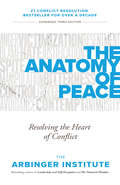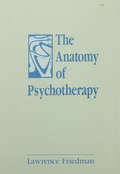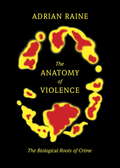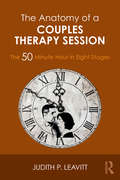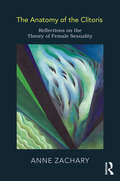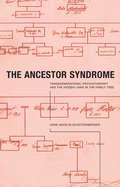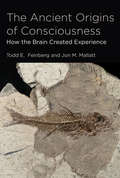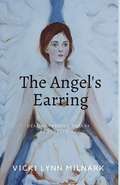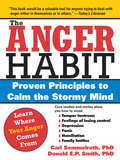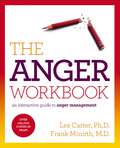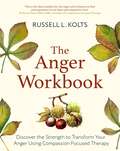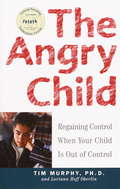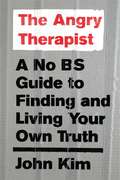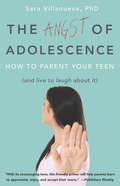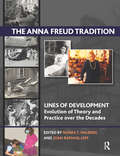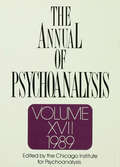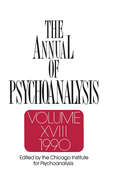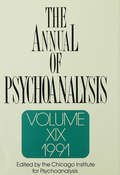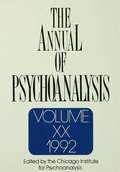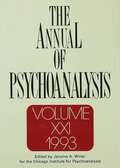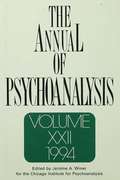- Table View
- List View
The Anatomy of Peace: Resolving the Heart of Conflict (Bk Life Ser.)
by The Arbinger InstituteFrom the authors of Leadership and Self-Deception, which sold over 2 million copies, this new edition explores how we misunderstand the causes of our conflicts and shows us the paths to achieving true peace within ourselves, in our relationships, and even between nations. In this day and age, perhaps there is nothing more important than knowing how to heal relationships that are breaking and how to maintain connections when people are pulling apart. So many of our conflicts seem unsolvable, but what if conflicts at home, at work, and in the world stem from the same root cause? What if we systematically misunderstand that cause? And what if, as a result, we unwittingly perpetuate the very problems we think we are trying to solve?This book unfolds as a story. Yusuf al-Falah, an Arab, and Avi Rozen, a Jew, each lost his father at the hands of each other's cousins. The Anatomy of Peace is the story of how they come together, how they help their warring parents and children come together, and how we too can find our way out of the personal, professional, and global conflicts that weigh us down. This expanded third edition includes diagrams and discussions that further explain some of the book's approaches, current research about key ideas, and how the transformation approach in the book relates to Arbinger's comprehensive organizational mindset-change process.
The Anatomy of Power
by John Kenneth GalbraithA critical analysis of power by renowned author John Kenneth Galbraith, where he discusses its origins and manifestations, and culminates in a discussion of the response to power in a largely democratic context.
The Anatomy of Psychotherapy
by Lawrence FriedmanOver the past decades, Lawrence Friedman has emerged as one of the most erudite and provocative theoriss in contemporary psychotherapy. The Anatomy of Psychotherapy interweaves Friedman's major contributions to the analytic and psychiatric literature with extensive new material in arriving at an extraordinarily rich and nuanced appreciation of psychotherapy. The Anatomy of Psychotherapy describes how the therapist makes use of theories and styles in order to achieve equilibrium under stress. This stress, according to Friedman, is related to the "absolute ambiguity" that is essential to psychotherapy. To cope with this ambiguity, the therapist alternates among three different roles, those of reader, historian, and pragmatic operator. Friedman examines these "disambiguating postures" in detail, paying special attention to their bearing on the therapist's narrative prejudice, the relativity of his knowledge, and the relationship of his work to natural science and hermeneutics. Brilliantly constructed and masterfully written, The Anatomy of Psychotherapy traverses the same basic themes in each of its six sections. Readers who are interested in theory can hone in on relevant topics or the work of particular theorists. Readers seeking insight into the demands of daily clinical work, on the other hand, can bypass the systematic studies and immerse themselves in Friedman's engrossing reflections on the experience of psychotherapy. Best served will be those who ponder Friedman's writings and therapy as complementary meditations issuing from a single, unifying vision, one in which psychotherapy, in both its promise and frustrations, becomes a subtle interplay among theories about psychotherapy, the personal styles of psychotherapists, and the practical exigencies of aiding those in distress.
The Anatomy of Regret: From Death Instinct to Reparation and Symbolization through Vivid Clinical Cases
by Susan Kavaler-AdlerAnatomy of Regret has a highly clinical focus, with cases that illustrate how critical psychic change can emerge from the mourning of the grief of "psychic regret". This book highlights the developmental achievement of owning the guilt of aggression, and of tolerating insight into the losses one had produced. The author uses the term "psychic regret" to capture the essence of the process of facing regret consciously. This is in contrast to the split-off and persecutory dynamics of unconscious guilt. Unconscious guilt exposes itself through visceral and cognitive impingements, which are related to internal world enactments, and it relies on unconscious avoidance of the pain and loss involved in facing psychic regret. The author's theory of "developmental mourning" is illustrated in this book through in-depth lively clinical processes (cases and vignettes).
The Anatomy of Sex and Power: An Investigation Of Mind-body Politics
by Michael HutchisonIs it possible that power— the desire that men and women, liberals and conservatives, have to possess it, wield it—has biological roots as strong as those of sex, producing ecstasies and rewards that are just as sensual and erotic? Yes, answers Michael Hutchison, to these and other questions, in this pioneering and assuredly controversial book. The brain revolution of today—the technological knowledge of what goes on in the brain—is as tradition- shattering as was the sexual revolution of the sixties. The Anatomy of Sex and Power explores the implications of both revolutions by drawing on recent research in such diverse areas as evolutionary biology, anthropology, neuroanatomy, biopolitics, and information theory. Hutchison finds that sex and power are fused in largely unsuspected ways, and that the evidence suggests our world is moved by sexual desires disguised as political ideologies and by the quest for power masked as sexual moralizing. He begins with a provocative historical overview, tracing the evolution of the forces in America that have become the most powerful practitioners of sexual politics—liberals, conservatives, descendants of the sixties counterculture and Human Potential movements, modern feminists, and religious fundamentalists—advocates all of different sexual agendas and conflicting strategies for gaining and using power. Moving from the sexual revolution of the sixties to what the author calls the “brain- mind revolution” of the seventies and after, The Anatomy of Sex and Power examines the wealth of scientific findings revealing that many biological differences, not only between the sexes, but also between personality types as distinct as risk-takers and risk-avoiders, are innate, the result of a natural selection process that has taken place over millions of years. And we see how such differences emerge not just in individuals, but in nations, cultures, and mass movements. But perhaps the most significant consequence of the new science is how it provides unique insights into contemporary politics. As The Anatomy of Sex and Power shows, many of today’s most divisive and explosive issues —including the Reagan-Bush economic and foreign policy agendas, the battle over reproductive rights, the effort to limit First Amendment guarantees — must be seen not only as conflicts between groups of individuals with biologically different personalities, but as ideological struggles to determine who among them will control virtually all aspects of political thought and social behavior. In exposing the stunning complexities of sex and power—the power of sex and the sexuality of power—Michael Hutchison’s bold, visionary synthesis turns a bright light on the emotionally charged issues of our time, and his book will leave no reader unmoved. He argues eloquently that as we free ourselves from the “hard-wired” behavior patterns of biological evolution and for the first time in human history begin to take control of our own evolution, our greatest power is information, and those who would limit its free flow pose the gravest danger to freedom and survival.
The Anatomy of Violence: The Biological Roots of Crime
by Adrian RaineWith an 8-page full-color insert, and black-and-white illustrations throughoutWhy do some innocent kids grow up to become cold-blooded serial killers? Is bad biology partly to blame? For more than three decades Adrian Raine has been researching the biological roots of violence and establishing neurocriminology, a new field that applies neuroscience techniques to investigate the causes and cures of crime. In The Anatomy of Violence, Raine dissects the criminal mind with a fascinating, readable, and far-reaching scientific journey into the body of evidence that reveals the brain to be a key culprit in crime causation. Raine documents from genetic research that the seeds of sin are sown early in life, giving rise to abnormal physiological functioning that cultivates crime. Drawing on classical case studies of well-known killers in history--including Richard Speck, Ted Kaczynski, and Henry Lee Lucas--Raine illustrates how impairments to brain areas controlling our ability to experience fear, make good decisions, and feel guilt predispose us to violence. He contends that killers can actually be coldhearted: something as simple as a low resting heart rate can give rise to violence. But arguing that biology is not destiny, he also sketches out provocative new biosocial treatment approaches that can change the brain and prevent violence. Finally, Raine tackles the thorny legal and ethical dilemmas posed by his research, visualizing a futuristic brave new world where our increasing ability to identify violent offenders early in life might shape crime-prevention policies, for good and bad. Will we sacrifice our notions of privacy and civil rights to identify children as potential killers in the hopes of helping both offenders and victims? How should we punish individuals with little to no control over their violent behavior? And should parenting require a license? The Anatomy of Violence offers a revolutionary appraisal of our understanding of criminal offending, while also raising provocative questions that challenge our core human values of free will, responsibility, and punishment.
The Anatomy of a Couples Therapy Session: The 50 Minute Hour in Eight Stages
by Judith P. LeavittHow does a couples’ therapist actually run a 50–minute session? What needs to happen? What must happen? Managing this time and knowing how to guide a couple through what can be a rocky roller coaster ride is a critical skill. This volume breaks down the entire 50 minutes of a couple’s therapy session from beginning to end. It divides the 50 minutes into eight time period stages that may overlap. The distinctive characteristics and challenges of each time period are examined. Numerous case examples are given throughout the book. The couples therapist is addressed directly with many suggestions given for handling the situations that can arise in each period. In addition, the couples therapist’s own experiences during the session are explored.
The Anatomy of the Clitoris: Reflections on the Theory of Female Sexuality
by Anne ZacharyIn the long and passionate debate within psychoanalysis over the theory of female sexuality, which has spanned more than a century and reached no definitive conclusion, a pattern of non-acceptance of ideas, their disappearance and then re-emergence later is a continually repeating one. The Anatomy of the Clitoris shows how this happens, using a comprehensive guide to the literature. The time is right culturally to explore this further usingclinical material as illustration. The central aim of this book is to introduce recent innovative redrawing of female anatomy appearing in the scientific literature to psychoanalysis.
The Ancestor Syndrome: Transgenerational Psychotherapy and the Hidden Links in the Family Tree
by Anne Ancelin SchutzenbergerIn The Ancestor Syndrome Anne Ancelin Schutzenberger explains and provides clinical examples of her unique psychogenealogical approach to psychotherapy. She shows how, as mere links in a chain of generations, we may have no choice in having the events and traumas experienced by our ancestors visited upon us in our own lifetime. The book includes fascinating case studies and examples of 'genosociograms' (family trees) to illustrate how her clients have conquered seemingly irrational fears, psychological and even physical difficulties by discovering and understanding the parallels between their own life and the lives of their forebears. The theory of 'invisible loyalty' owed to previous generations, which may make us unwittingly re-enact their life events, is discussed in the light of ongoing research into transgenerational therapy. Anne Ancelin Schutzenberger draws on over 20 years of experience as a therapist and analyst and is a well-respected authority, particularly in the field of Group Therapy and Psychodrama. First published as Aie, mes Aieux this fascinating insight into a unique style of clinical work has already sold over 32,000 copies in France and will appeal to anyone working in the psychotherapy profession.
The Ancient Origins of Consciousness: How the Brain Created Experience
by Todd E. Feinberg Jon M. MallattHow consciousness appeared much earlier in evolutionary history than is commonly assumed, and why all vertebrates and perhaps even some invertebrates are conscious.How is consciousness created? When did it first appear on Earth, and how did it evolve? What constitutes consciousness, and which animals can be said to be sentient? In this book, Todd Feinberg and Jon Mallatt draw on recent scientific findings to answer these questions—and to tackle the most fundamental question about the nature of consciousness: how does the material brain create subjective experience? After assembling a list of the biological and neurobiological features that seem responsible for consciousness, and considering the fossil record of evolution, Feinberg and Mallatt argue that consciousness appeared much earlier in evolutionary history than is commonly assumed. About 520 to 560 million years ago, they explain, the great “Cambrian explosion” of animal diversity produced the first complex brains, which were accompanied by the first appearance of consciousness; simple reflexive behaviors evolved into a unified inner world of subjective experiences. From this they deduce that all vertebrates are and have always been conscious—not just humans and other mammals, but also every fish, reptile, amphibian, and bird. Considering invertebrates, they find that arthropods (including insects and probably crustaceans) and cephalopods (including the octopus) meet many of the criteria for consciousness. The obvious and conventional wisdom–shattering implication is that consciousness evolved simultaneously but independently in the first vertebrates and possibly arthropods more than half a billion years ago. Combining evolutionary, neurobiological, and philosophical approaches allows Feinberg and Mallatt to offer an original solution to the “hard problem” of consciousness.
The Angel's Earring: Healing through Dreams and Creativity
by Vicki Lynn Milnark"Shame and introversion kept me silent most of my life, without stories. Yet off in a dark, lonely place at the top of the world, she saved me. ... She told me to paint as just a voice in a dream." Through years of self-hatred, Vicki Lynn Milnark kept receiving signals, images in her dreams that she explored through her artwork. Slowly, but surely, it profoundly altered her self-awareness, allowing her mind to become healthy and well. <p><p> An inspirational work, Vicki describes the profound insights she received and shares the drawings and paintings that let her discover personal joy and her true potential. Her path wound through Christianity, Gnosticism, Judaism, Neopaganism, Alchemy, Buddhism, shamanism, mask and myth, and along the way she loosened the constrictions binding her and came to understand how to obtain freedom and comfort. Join Vicki as she recounts her travels - and begin an enlightening journey of your own! The author has eighteen years’ experience as a counselor and art therapist in a variety of settings with children and adults. Those include a renal care facility, elementary schools, a senior center, individual art therapy for adolescents, and medical art therapy. This is her first book.
The Anger Habit
by Carl Semmelroth Donald E. P. SmithCarl Semmelroth's The Anger Habit is a leading anger-management book that is poised to become a major force in the category. This book is centered around the principle that for those who have anger problems, anger can be a learned response. Often the people with the problem don't realize that they are acting habitually, or why they are. Semmelroth takes you step by step through the process of identifying and getting over the anger habit. Case studies and stories show you how to avoid:- Feelings of losing control- Depression- Panic- Family battles
The Anger Workbook: An Interactive Guide to Anger Management
by Frank Minirth Les CarterA field guide to understanding and managing anger--what it is, where it comes from, and how to get it under control.Many people assume that anger is the emotion that leads to raised voices and violence, and this kind of explosive rage is certainly a reality. But there are many different types of anger, from the simmering to the shutting down. Most of us experience some form of anger or its effects. The good news is that anger can be controlled.Founded on thirteen faith-based steps designed to recognize and manage anger, The Anger Workbook is an interactive guide to transforming patterns and behaviors with the help of biblical principles and evidence-based treatment.Best-selling author and practicing counselor Les Carter, Ph.D. and author and Christian psychiatrist Frank Minirth, M.D. draw on their years of experience and expertise to demystify the problem of anger. Throughout this workbook, you will learn:How to identify situational anger in yourself or others as well as patterns of relating, thinking, and behaving that may lead to feelings of angerHow emotions like fear, loneliness, and inferiority create angerHow to uncover and eliminate myths that perpetuate anger such as, "Letting go of my anger means I am conceding defeat." Or "No one understand my unique problems."For parents: how to manage a child's angerAs we get to know and understand anger--whether it's our own or a loved one's--its management becomes far less daunting. Anger can be controlled.
The Anger Workbook: Discover the Strength to Transform Your Anger Using Compassion Focused Therapy (Compassion Focused Therapy)
by Russell KoltsAnger is one of the most difficult emotions for human beings to cope with. If our anger is unmanaged, we can end up behaving in destructive ways towards both ourselves and other people, and can face relationship difficulties and negative health consequences. Far from 'letting ourselves off the hook', recent research has shown that by developing compassion towards ourselves and others and compassionately understanding our anger and the factors that fuel it, we can connect with the courage and skills needed to change our behaviour. This fascinating and practical self-help guide will give you a number of powerful techniques for tackling your anger head on and taking control of it, rather than letting it control you. USING THIS WORKBOOK, READERS WILL LEARN ABOUT: - The factors that trigger and fuel our anger, how it works and how to change the anger response - Specific skills to manage anger and improve relationships Filled with interactive exercises and practical skills, The Anger Workbook will guide you in your journey to transform your anger into inner strength. THE COMPASSIONATE MIND APPROACH The self-help books in this series are based on compassion focused therapy (CFT, developed by series editor Paul Gilbert). This brings together an understanding of how our mind can cause us difficulties but also provides us with a powerful solution in the shape of mindfulness and compassion. It teaches ways to stimulate the part of the brain connected with kindness, warmth, compassion and safeness, and to calm the part that makes us feel, anxious, angry, sad or depressed.
The Anger Workbook: Discover the Strength to Transform Your Anger Using Compassion Focused Therapy (Compassion Focused Therapy)
by Russell KoltsAnger is one of the most difficult emotions for human beings to cope with. If our anger is unmanaged, we can end up behaving in destructive ways towards both ourselves and other people, and can face relationship difficulties and negative health consequences. Far from 'letting ourselves off the hook', recent research has shown that by developing compassion towards ourselves and others and compassionately understanding our anger and the factors that fuel it, we can connect with the courage and skills needed to change our behaviour. This fascinating and practical self-help guide will give you a number of powerful techniques for tackling your anger head on and taking control of it, rather than letting it control you. USING THIS WORKBOOK, READERS WILL LEARN ABOUT: - The factors that trigger and fuel our anger, how it works and how to change the anger response - Specific skills to manage anger and improve relationships Filled with interactive exercises and practical skills, The Anger Workbook will guide you in your journey to transform your anger into inner strength. THE COMPASSIONATE MIND APPROACH The self-help books in this series are based on compassion focused therapy (CFT, developed by series editor Paul Gilbert). This brings together an understanding of how our mind can cause us difficulties but also provides us with a powerful solution in the shape of mindfulness and compassion. It teaches ways to stimulate the part of the brain connected with kindness, warmth, compassion and safeness, and to calm the part that makes us feel, anxious, angry, sad or depressed.
The Angry Child: Regaining Control When Your Child Is Out of Control
by Loriann Hoff Oberlin Congressman Tim MurphyEvery child has an off day when nothing seems to go right, but for some, angry outbursts, frustration, and resentment are the norm. When a child's anger threatens to jeopardize his school and social life and introduces an element of strain into the family dynamics that affects every member, it's time for a parent to ask: When is angry too angry? Child psychologist Dr. Tim Murphy has addressed this very question with hundreds of families, helping them to understand both the causes and the repercussions of childhood anger and to devise effective strategies for defusing the time bomb in their midst. Whether it's a toddler staging a tantrum, a grade-schooler unable to make friends, or a sulking preteen who greets every adult request with antagonism, parents of angry children are baffled by both the depth and the root of their child's unhappiness. And when small social problems and household disputes regularly escalate into full-fledged battles, it's nearly impossible for parents to distance themselves enough from the situation to find a perspective that will remedy it. With simple, direct techniques, Dr. Murphy shows it is possible to help an angry child understand what triggers his outbursts and develop new approaches for coping with potentially explosive situations. Identifying the ten telling characteristics of an angry child, Dr. Murphy provides examples from his clinical experience to help adults guide their children to more appropriate responses. Dr. Murphy also alerts readers to parenting styles that work best for these volatile children, explaining how a parent's own behavior can sometimes escalate a child's meltdowns. He pinpoints the moments when anger moves from a normal emotional expression to an extreme one, indicative of a larger problem. In a special chapter devoted to winning daily battles, Dr. Murphy offers advice on situations in which an angry child's temper is most likely to flare. The Angry Child is destined to be a classic. With real solutions for the concerns of millions of parents, Dr. Murphy offers answers and hope for the families and educators of unhappy children of all ages. From the Hardcover edition.
The Angry Therapist: A No BS Guide to Finding and Living Your Own Truth
by John KimTackling relationships, career, and family issues, John Kim, LMFT, thinks of himself as a life-styledesigner, not a therapist. His radical new approach, that he sometimes calls “self-help in a shot glass” is easy, real, and to the point. He helps people make changes to their lives so that personal growth happens organically, just by living. Let’s face it, therapy is a luxury. Few of us have the time or money to devote to going to an office every week. With anecdotes illustrating principles in action (in relatable and sometimes irreverent fashion) and stand-alone practices and exercises, Kim gives readers the tools and directions to focus on what's right with them instead of what's wrong. When John Kim was going through the end of a relationship, he began blogging as The Angry Therapist, documenting his personal journey post-divorce. Traditional therapists avoid transparency, but Kim preferred the language of "me too" as opposed to "you should." He blogged about his own shortcomings, revelations, views on relationships, and the world. He spoke a different therapeutic language —open, raw, and at times subversive — and people responded. The Angry Therapist blog, that inspired this book, has been featured in The Atlantic Monthly and on NPR.
The Angst of Adolescence: How to Parent Your Teen and Live to Laugh About It
by Sara VillanuevaBeing a good parent is one of the most difficult, yet most rewarding, jobs a person can have in his or her lifetime. Being the parent of a teen is an especially daunting phase of the journey. As parents begin to notice the significant changes that come with adolescence, they wonder just what happened to their happy, sweet, and affectionate young boy or girl. Parents sit by amazed--and often lost and unprepared--as they witness their child morph and mutate into a full-blown pubescent display of emotions. The Angst of Adolescence: How to Parent Your Teen and Live to Laugh About It, written in a conversational, informative, humorous and relatable style, promises to deliver trustworthy resource for parents of teens who are searching for answers and guidance about how to maneuver their way through this tricky developmental period. Dr. Sara Villanueva, a prominent psychologist specializing in the adolescent years, shares relevant research findings so that parents can be informed of the facts as opposed to making assumptions based on ubiquitous but questionable sources. Most of all it will provide parents of teenagers with prospective in the midst of the angst so they can come away with the sense that: (1) they are not alone in their experience of raising teens; many, many people have gone through it and we can all relate to and learn from one another; (2) most of what your teen is feeling and expressing is normal and falls within the expected range of behavior for adolescent development; and (3) despite the challenges involved in parenting teens, we should take time to focus on the positive things in life and live with our child through the tough adolescent years so that we emerge on the other side with friendship and a deeper bond. As a psychologist and mother of four, the author shares both research-based and first-hand advice on how to navigate the teen years and live to laugh about it.
The Anna Freud Tradition: Lines of Development - Evolution of Theory and Practice over the Decades (The\lines Of Development - Evolution Of Theory And Practice Over The Decades Ser.)
by Norka T. MalbergThis book introduces the birth and development of the Anna Freudian Tradition from a perspective of developmental lines, by addressing the early development of this tradition and the conflicts and innovations arising from the interaction between the internal and external world of the organization.
The Annual of Psychoanalysis, V. 17: Rethinking Psychoanalysis And The Homosexualities
by Jerome A. WinerVolume 17, the first volume of The Annual published by The Analytic Press, includes John Gedo's examination of the "epistemology of transference" and Edwin Wallace's outline of a "phenomenological and minimally theoretical psychoanalysis." Studies in applied psychoanalysis focus on the art of Edvard Munch (Mavis and Harold Wylie); George Eliot's Romolo (Jerome Winer); and psychoanalysis and music (Martin Nass).
The Annual of Psychoanalysis, V. 18: Rethinking Psychoanalysis And The Homosexualities (Annual Of Psychoanalysis Ser. #Vol. 33)
by Jerome A. WinerA highlight of Volume 18 is two developmental studies that attempt to situation psychoanalysis within the landscape of contemporary science: R. Galatzer-Levy and B. Cohler's examination of the developmental psychology of the self and F. Levin's consideration of psychological development and the changing organization of the Brain. Clinical studies focus on analytic stalemate (J.G. Maguire); the dream screen transference (D. Edelstein); and varieties of therapeutic alliance (B. Brandchaft and R. Stolorow).
The Annual of Psychoanalysis, V. 19
by Jerome A. WinerVolume 19 of The Annual of Psychoanalysis turns to the ever-intriguing relationship between "Psychoanalysis and Art." This introductory section begins with Donald Kuspit's scholarly reflections on the role of analysis in visual art and art criticism, and then proceeds to a series of topical studies on Freud and art introduced by Harry Trosman. Egyptologist Lorelei Corcoran explores the Egypt of Freud's imagination, thereby illuminating our understanding of the archaeological metaphor. Marion Tolpin offers new insights into Freud's analysis of the American writer Hilda Doolittle by focusing on the meaning of the Goddess Athene - whose statue rested on Freud's desk - to both analyst and analysand. Stephen Toulmin examines Freud's artistic sensibility - and places the historical significance of Freud's art collection in bold relief - by looking at the many contemporary art objects Freud chose not to collect. Danielle Knafo identifies key events in the early life of Austrian Expressionist Egon Schiele that were "primary determinants" of the content and form of his self-portraits. And Barbara Almond examines the spontaneous healing process depicted in Margaret Drabble's novel The Needle's Eye as an analogue to the kind of growth and development mobilized by the psychoanalytic process. Section II, "Psychoanalysis and Development," begins with Barbara Fajardo's appreciation of the contribution of biology to analyzability; she reviews findings from both infant research and biogenetic research that tend toward an understanding of "constitution" as resilience in development and, subsequently, in treatment. Benjamin Garber adds to the psychoanalytic understanding of childhood learning disabilities by presenting the three-and-a-half-year analysis of a learning-disabled child. In a fascinating two-part contribution, "Bridging the Chasm Between Developmental Theory and Clinical Theory," Joseph Palombo sheds light on some of the knottiest problems in contemporary analysis, including the relationship between childhood events and the reconstruction of those events in treatment. In Section III, "Psychoanalysis and Empathy," Mary Newsome presents case material in support of her claim that the analyst's empathic understanding catalyzes the coalescence of the patient's affect and aim, that is, the patient's capacity to believe in and then realize his ambitions. The acquisition of the capacity, she contends, not only betokens a specific kind of structure formation, but is the bedrock of emerging self-cohesion. Her challenging paper is thoughtfully discussed by David Terman and Jerome Winer. Section IV of The Annual offers Jerome Kavka's appreciation of the work of N. Lionel Blitzsten (1893-1952). Blitzsten, the first Chicago psychoanalyst and one of America's most gifted clinicians and teachers, anticipated modern concepts of narcissism in identifying "narcissistic neuroses" with special treatment requirements. Morris Sklansky furthers our understanding of Blitzsten in his discussion of Kavka's essay. Ranging across the analytic canvas with presentations as edifying as they are provocative, volume 19 of The Annual of Psychoanalysis challenges readers to wrestle with issues at the cutting edge of the discipline. It takes a well-deserved place in the preeminent continuing series in the field.
The Annual of Psychoanalysis, V. 20: Rethinking Psychoanalysis And The Homosexualities (Annual Of Psychoanalysis Ser. #Vol. 33)
by Jerome A. WinerVolume 20 of The Annual of Psychoanalysis ably traverses the analytic canvas with sections on "Theoretical Studies," "Clinical Studies," "Applied Psychoanalysis," and "Psychoanalysis and Philosophy." The first section begins with Arnold Modell's probing consideration of the paradoxical nature of the self, provocatively discussed with John Gedo. Modell focuses on the fact that the self is simultaneously public and private, dependent and autonomous. Alice Rosen Soref next explores innate motivation and self-protective regulatory processes from the standpoint of recent infancy research; her notion of a lifelong two-track model of self and relatedness helps establish a normative baseline that can anchor psychoanalytic theory. George Mahl makes an interesting contribution to Freud studies in the form of a new chronology of Freud's works and the number of pages they contain in the Standard Edition. The section ends with Robert Galatzer-Levy and Mayer Gruber's "quasi-experiment about disgust." They test and disconfirm the hypothesis that disgust is an affective response to an abstract sense of disorder rather than a transformation of a concrete, bodily experience by systematically exploring references to concepts of disgust in the Old Testament. Section II, on "Clinical Studies," opens with Henry Smith's fascinating elaboration of Freud's notion of "screen memories" into a theory of screening that denotes the general process by which mental content is organized. He illustrates his thesis by invoking the "screen language" employed by a patient throughout her analysis. Ernest Wolf next explores the tension between being a "scientist" and a "healer" in Freud and his followers to illuminate struggles within the psychoanalytic movement and to help account for current attitudes toward abstinence, neutrality, and gratification. Kenneth Newman focuses on this same triptych of technical precepts. He argues, in the spirit of Winnicott and Kohut, that analysts can only alter the hostile internal environments of their patients by becoming "usable" objects and cultivating an optimally responsive analytic environment. A particularly rich collection of applied analytic studies forms Section III of the volume. Individual chapters focus on the childhood of Vincent van Gogh (W. W. Meissner); the psychological healing process depicted in George Eliot's Silas Marner (Richard Almond); the self-psychological meaning of "blood brotherhood" in D. H. Lawrence's Women in Love (James Cowan); ecstatic mysticism in the 19th-century Indian saint Sri Ramakrishna (Sudhir Kakar); the disintegration of the Tyrone family in Eugene O'Neill's Long Day's Journey into Night (Frank and Annette Lachmann); and the nature and analytic significance of Freud's aesthetic response to Michelangelo's Moses (Gary Goldsmith). Finally, in Section IV, George Brook examines the commonsense psychological knowledge of everyday life, that is, the nonpsychoanalytic knowledge on which much of clinical psychoanalysis ultimately depends. Taken together, the four sections of Volume 20 of The Annual offer an exciting overview of contemporary psychoanalysis. Section I highlights recent trends in psychoanalytic theorizing and the testing of psychoanalytic propositions; Section II explores the relevance of new theoretical perspectives to clinical work; Section III demonstrates the applicability of these new perspectives to psychobiographical and literary analysis; and Section IV provocatively explores the points of connection between everyday ideas and attitudes and the tenets of psychoanalytic practice.
The Annual of Psychoanalysis, V. 21: Rethinking Psychoanalysis And The Homosexualities (Annual Of Psychoanalysis Ser. #Vol. 33)
by Jerome A. WinerVolume 21 of The Annual of Psychoanalysis is especially welcome for bringing to English-language readers timely contributions from abroad in an opening section on "Psychoanalysis in Europe." The section begins with a translation of Helmut Thomae's substantial critique of the current state of psychoanalytic education; Thomae's proposal for comprehensive reform revolves around a redefinition of the status of the training analysis in analytic training. Diane L'Heureux-Le Beuf's clinical diary of an analysis focusing on the narcissistic elements of oedipal conflict probes the degree to which the analytic method can be applied to "nonstructured" analysands. And Nella Guidi shows the clinical value of supplementing Freud's notion of unobjectionable positive transference with the complementary notion of unobjectionable negative transference. Section II, on "Psychoanalysis and Hysteria," offers original contributions to Freud scholarship in the form of Jules Glenn's reconsideration of Dora's "Dynamics, Diagnosis, and Treatment"; William McGrath's analysis of the way Freud's hostility to religious superstition gained expression in his early work on hysteria; and Marian Tolpin's self-psychological reprise on the case of Anne O. The section concludes with Elisabeth Young-Bruehl and Sarah Cummin's provocative "What Happened to 'Anorexie Hysterique'?" which questions the contemporary separation of anorexia from hysteria and explore the sociohistorical reasons the separation came about. Section III, "Clinical and Theoretical Studies," begins with Nancy Kobrin's discussion of Freud's ideas about autonomy, including the terms Freud used and the way Strachey translated them into English. Her goal is to deepen our understanding of how Freud spoke and thought about an individual's sense of self. Frank Summers shows how object relations principles, which are shared by various object relations theories, can inform the conduct of analysis at all levels of pathology, including neurosis. And Henry Smith examines the meaning and value of the "analytic surface," a metaphor that highlights the relationship between the analyst's attention and the patient's attention. A final section on "Applied Psychoanalysis" offers contemporary examples of applied analytic inquiry in anthropology, art, and literature. Roy Grinker, III and Roy Grinker, Jr., in a methodological contribution to psychoanalytic anthropology, examine what is revealed when a native people (here the Lese of northeastern Zaire in Africa) are asked to retell a story (here the story of Cain and Abel) introduced by them by their Western observers. Danielle Knafo explores the art and life of the Mexican surrealist Frida Kahlo through the concepts of the mirror, the mask, and the masquerade. And David Werman closes the volume with a comparative study of Edgar Allan Poe's and James Ensor's obsession with revenge, and the role it played in Poe's writing and Ensor's etchings, respectively. Bringing readers the influential reform proposals of Thomae, a rich sampling of recent Freud scholarship, applied contributions traversing three disciplines, and original clinical contributions reflecting American and European sensibilities, Volume 21 of The Annual is true to the spirit of this distinguished series. It testifies to the scope of analytic inquiry, and it exemplifies the yield of such inquiry in the hands of gifted scholars and clinicians.
The Annual of Psychoanalysis, V. 22: Rethinking Psychoanalysis And The Homosexualities (Annual Of Psychoanalysis Ser. #Vol. 33)
by Jerome A. WinerVolume 22 of The Annual of Psychoanalysis begins with the provocative reflections of Jane Flax and Robert Michels on the current status and future prospects of psychoanalysis a century after Freud. Flax believes that analysis will not survive in the postmodern West if analysts cling to the medical model and the notion of analysis as a clinical science; Michels believes analysis will be revivified in the next century by reorganizing its training institutes within universities. A section on "Psychoanalysis and the Visual Arts" includes John Gedo's probing examination of the inner world of Paul Gauguin and William Meissner's reflections on Vincent van Gogh as artist. Johann Michael Rotmann's examination of the transferential meanings of third-party payment within Germany's health insurance system is a timely consideration of issues that are increasingly salient for American analysts and therapists. A rich harvest of theoretical and clinical papers rounds out this volume of The Annual. In "A Time of Questioning," Leon Wurmser responds to the inner and outer challenges before analysis in a closely reasoned defense of the applicability of classical analytic technique to severely disturbed patients. Michael Hoit examines the noninterpretive, interactive aspects of the analytic relationship, arguing that the analyst's noninterpretive activities are intrinsic to treatment and must be incorporated into the theory of therapeutic action. In "Fables as Psychoanalytic Metaphors," Elaine Caruth describes some psychoanalytic metaphors contained within the lessons of the Aesopian fables, proposing that the fables address interpersonal and group conflicts that often involve moral issues. Wilma Bucci offers her "multiple code theory" as a new model of emotion and mind, based on current theory and research in cognitive science, that can account for clinical concepts and provide coherent framework for empirical research. And Ralph Roughton uses the case history of Laura to underscore the central role of repetition and interaction in the analytic process. Volume 22 will not disappoint readers of this distinguished continuing series. Like its predecessors, it is a thoroughly assembled collection responsive to the conceptual, clinical, and institutional challenges now before the field.
